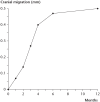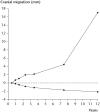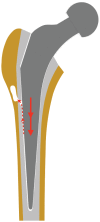Is early migration enough to explain late clinical loosening of hip prostheses?
- PMID: 32175098
- PMCID: PMC7047901
- DOI: 10.1302/2058-5241.5.190014
Is early migration enough to explain late clinical loosening of hip prostheses?
Abstract
Prosthetic loosening has been debated for decades, both in terms of the timing and nature of the triggering events. Multiple radiostereometric studies of hip prostheses have now shown that early migration poses a risk of future clinical failure, but is this enough to explain late clinical loosening?To answer this question, the progression of loosening from initiation to radiographic detection is described; and the need for explanations other than early prosthetic loosening is analysed, such as stress-shielding, particle disease, and metal sensitivity.Much evidence indicates that prosthetic loosening has already been initiated during or shortly after the surgery, and that the subsequent progression of loosening is affected by biomechanical factors, fluid pressure fluctuations and inflammatory responses to necrotic cells and cell fragments, i.e. the concept of late loosening appears to be a misinterpretation of late-detected loosening.Clinical implications: atraumatic surgery and initial prosthetic stability are crucial in ensuring low risk of prosthetic loosening. Cite this article: EFORT Open Rev 2020;5:113-117. DOI: 10.1302/2058-5241.5.190014.
Keywords: periprosthetic osteolysis; prosthetic loosening; radiostereometric analysis.
© 2020 The author(s).
Conflict of interest statement
ICMJE Conflict of interest statement: The author declares no conflict of interest relevant to this work.
Figures



Similar articles
-
Hip prosthetic loosening: A very personal review.World J Orthop. 2021 Sep 18;12(9):629-639. doi: 10.5312/wjo.v12.i9.629. eCollection 2021 Sep 18. World J Orthop. 2021. PMID: 34631447 Free PMC article. Review.
-
Hip prosthetic loosening and periprosthetic osteolysis: A commentary.World J Orthop. 2022 Jun 18;13(6):574-577. doi: 10.5312/wjo.v13.i6.574. eCollection 2022 Jun 18. World J Orthop. 2022. PMID: 35949708 Free PMC article. Review.
-
The theory of early loosening of hip prostheses.Orthopedics. 1997 Dec;20(12):1169-75. doi: 10.3928/0147-7447-19971201-12. Orthopedics. 1997. PMID: 9415912 Review.
-
Loosening of the cemented hip prosthesis. The importance of heat injury.Acta Orthop Scand Suppl. 1986;221:1-40. Acta Orthop Scand Suppl. 1986. PMID: 3468743
-
Conus hip prosthesis.Acta Chir Orthop Traumatol Cech. 2001;68(4):213-21. Acta Chir Orthop Traumatol Cech. 2001. PMID: 11706545
Cited by
-
Hip prosthetic loosening: A very personal review.World J Orthop. 2021 Sep 18;12(9):629-639. doi: 10.5312/wjo.v12.i9.629. eCollection 2021 Sep 18. World J Orthop. 2021. PMID: 34631447 Free PMC article. Review.
-
Roentgen stereophotogrammetric analysis: still a very valuable tool in the orthopaedic research armamentarium.Bone Joint Res. 2022 Apr;11(4):210-213. doi: 10.1302/2046-3758.114.BJR-2021-0593.R1. Bone Joint Res. 2022. PMID: 35369732 Free PMC article. No abstract available.
-
Surgical approach had minor association with femoral stem migration in total hip arthroplasty: radiostereometric analysis of 61 patients after 5-year follow-up.Acta Orthop. 2023 Aug 9;94:410-415. doi: 10.2340/17453674.2023.18264. Acta Orthop. 2023. PMID: 37563924 Free PMC article.
-
Hip prosthetic loosening and periprosthetic osteolysis: A commentary.World J Orthop. 2022 Jun 18;13(6):574-577. doi: 10.5312/wjo.v13.i6.574. eCollection 2022 Jun 18. World J Orthop. 2022. PMID: 35949708 Free PMC article. Review.
-
Continuous periprosthetic bone loss around the TOP® cup and inferior survival rate at an 8-year follow-up: a prospective cohort study.BMC Musculoskelet Disord. 2024 Sep 16;25(1):741. doi: 10.1186/s12891-024-07865-5. BMC Musculoskelet Disord. 2024. PMID: 39285412 Free PMC article.
References
-
- Selvik G. Roentgen stereophotogrammetry: a method for the study of the kinematics of the skeletal system (Reprint from the original 1974 thesis). Acta Orthop Scand Suppl 1989;232:1–51. - PubMed
-
- Mjöberg B. Loosening of the cemented hip prosthesis. Acta Orthop Scand Suppl 1986;221:1–40. - PubMed
-
- Ryd L, Albrektsson BE, Carlsson L, et al. Roentgen stereophotogrammetric analysis as a predictor of mechanical loosening of knee prostheses. J Bone Joint Surg Br 1995;77-B:377–383. - PubMed
Publication types
LinkOut - more resources
Full Text Sources

